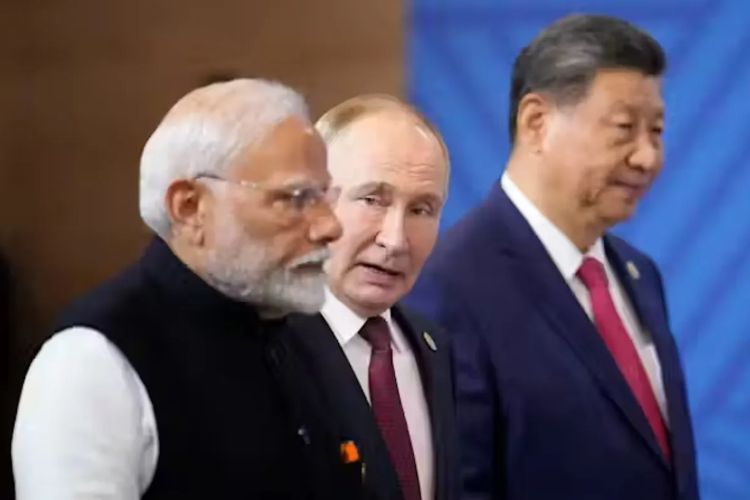With the Modi–Trump rapport fraying, Prime Minister Narendra Modi has embarked on a strategic tour of Asia’s two major powers. His first stop is Japan, followed by a visit to China for the Shanghai Cooperation Organisation (SCO) summit in Tianjin on August 31–September 1. The timing is significant: India is navigating an increasingly complex geopolitical landscape, and the SCO, led by China and Russia, has become a key platform for regional security, economic cooperation, and political alignment.
India’s participation at Tianjin comes against the backdrop of worsening ties with Washington. The Trump administration’s tariff hikes and pressure to cut energy ties with Russia have underscored the risks of overdependence on any single partner. India’s trade surplus with the US is substantial—larger than its combined exports to Russia and China—but that advantage is increasingly tenuous. The SCO offers no immediate economic alternative, but it provides a venue for India to assert strategic autonomy while resisting pressure from both Western and Eurasian powers.
For China and Russia, the SCO is often framed as a counterweight to American dominance. India, however, seeks a multipolar order that allows engagement with all major powers without joining exclusive blocs. This divergence has become sharper as Beijing consolidates influence in South Asia, gaining ground in Nepal, Sri Lanka, and the Maldives. At Tianjin, Modi is expected to stress sovereignty, non-alignment, and a rules-based order that avoids zero-sum contests.
READ I TCS, Infosys lead India’s shift to AI-driven IT services
China: The central challenge
India’s most immediate test at the SCO is its uneasy relationship with China. The border stand-off continues, with unresolved friction points in Depsang and Demchok. Trade remains heavily imbalanced, with Chinese restrictions on critical supplies like rare earth magnets exposing India’s vulnerabilities. At Tianjin, Modi may push for renewed dialogue on border management, disengagement, and incremental normalisation. Yet expectations are limited. Beijing’s Belt and Road Initiative, its protection of Pakistan at the SCO, and its wider South Asia ambitions limit the scope for breakthroughs. India’s task is to combine pragmatic engagement with firm red lines on sovereignty and regional influence.
Counterterrorism was one of the SCO’s founding goals, but the forum has consistently avoided confronting Pakistan’s role in cross-border terrorism. Shielded by China, Islamabad has faced little scrutiny. India will use Tianjin to once again highlight Pakistan’s duplicity and press for a unified stance, warning that selective condemnation undermines the SCO’s credibility.
SCO: Economic cooperation on unequal terms
Trade within the SCO framework has yielded little for India. In 2024, India exported $5 billion to Russia and $15 billion to China, dwarfed by the $60 billion and $100 billion surpluses those countries run against India. With the SCO’s economic agenda dominated by China’s BRI, India has resisted debt-heavy infrastructure projects and instead pushed for alternative models—digital connectivity, renewable energy, and skill development. Modi is expected to emphasise these themes, seeking frameworks that align better with India’s interests and principles of transparency.
With SAARC moribund since 2014, China has used the SCO to expand its footprint in South Asia, backing Bangladesh’s entry and creating trilateral forums with Pakistan and Afghanistan. The inclusion of Afghanistan, Maldives, Myanmar, Nepal, and Sri Lanka as observers or dialogue partners has further shifted the balance. At Tianjin, India will have to demonstrate that it remains a reliable partner for its neighbours, signalling continued commitment to security and development cooperation outside Beijing’s orbit.
Central Asia and energy security
Despite these challenges, the SCO remains a critical entry point for India into Central Asia. The region is vital for energy and connectivity, and India’s projects—such as the Chabahar port and the International North-South Transport Corridor—offer viable alternatives to China’s BRI. Modi will likely highlight these initiatives to strengthen ties with Uzbekistan, Kazakhstan, and Kyrgyzstan, tapping into regional unease about Chinese dominance.
Russia remains central to India’s energy and defence security, even as its Ukraine war entanglements complicate matters. The SCO summit gives India a channel to reaffirm its ties with Moscow, balancing Western scrutiny with long-standing strategic cooperation. Yet New Delhi must be careful not to appear overly reliant on Russia, especially as Central Asian states seek greater independence from Moscow’s orbit.
Realistic gains, long-term strategy
India’s agenda at Tianjin is pragmatic: pursue incremental progress on border stability with China, press for stronger counterterrorism mechanisms, and push for economic cooperation beyond Beijing’s framework. The larger challenge will be countering China’s ambitions to dominate South Asia and Pakistan’s use of the SCO to shield itself diplomatically.
Meanwhile, Modi’s Tokyo stop offers opportunities to deepen maritime and technological partnerships with Japan—another hedge against Chinese assertiveness. The Tianjin summit is unlikely to deliver dramatic outcomes, but it provides India a stage to reassert its strategic autonomy and reinforce its influence in Asia’s shifting power balance.

